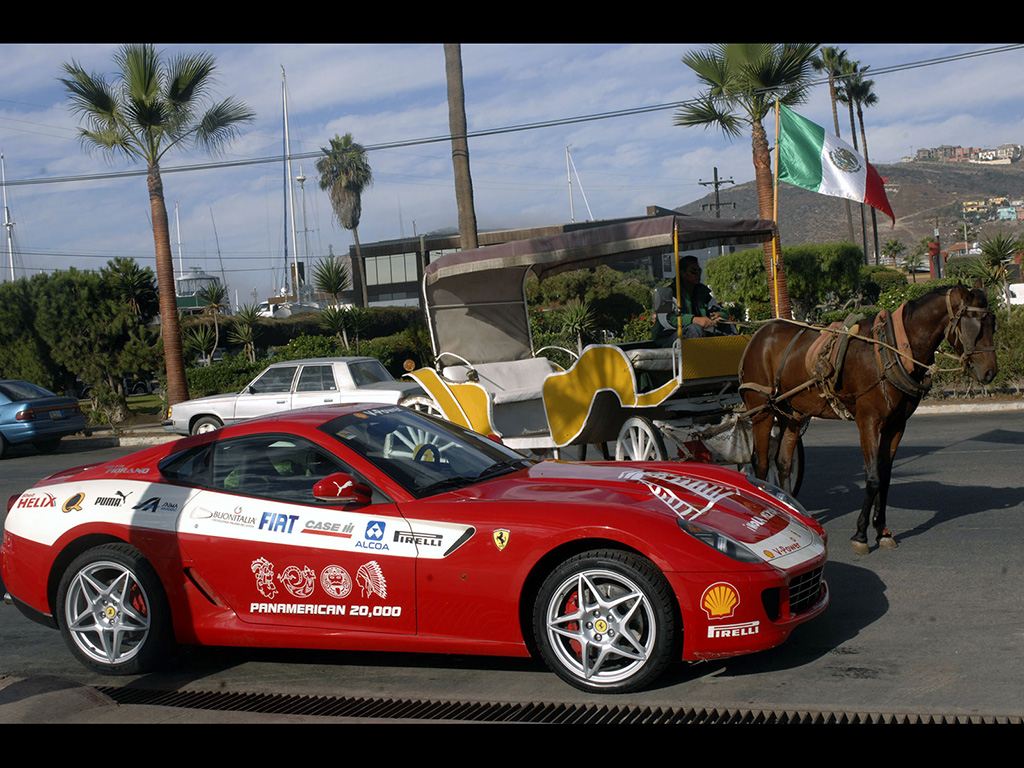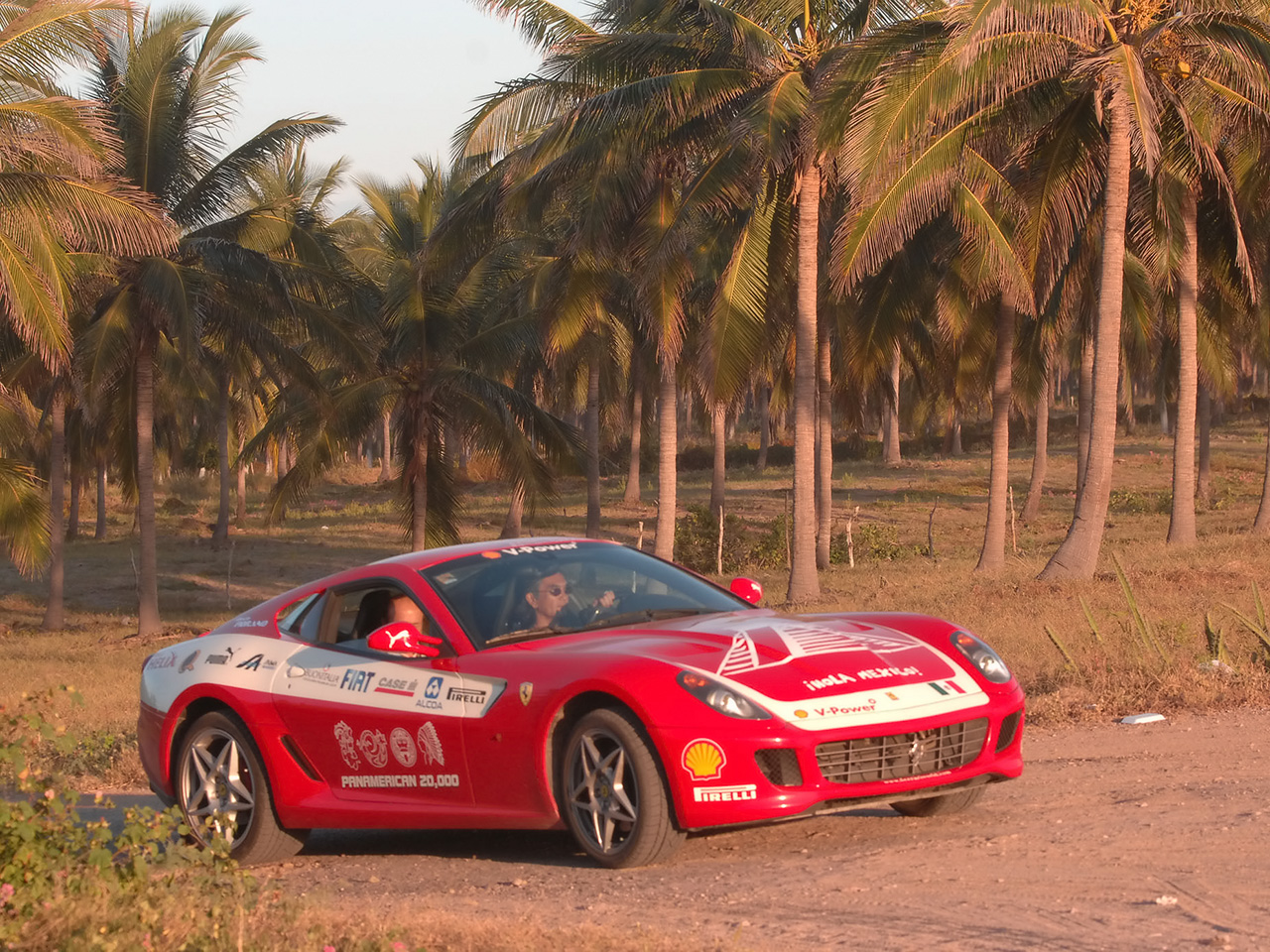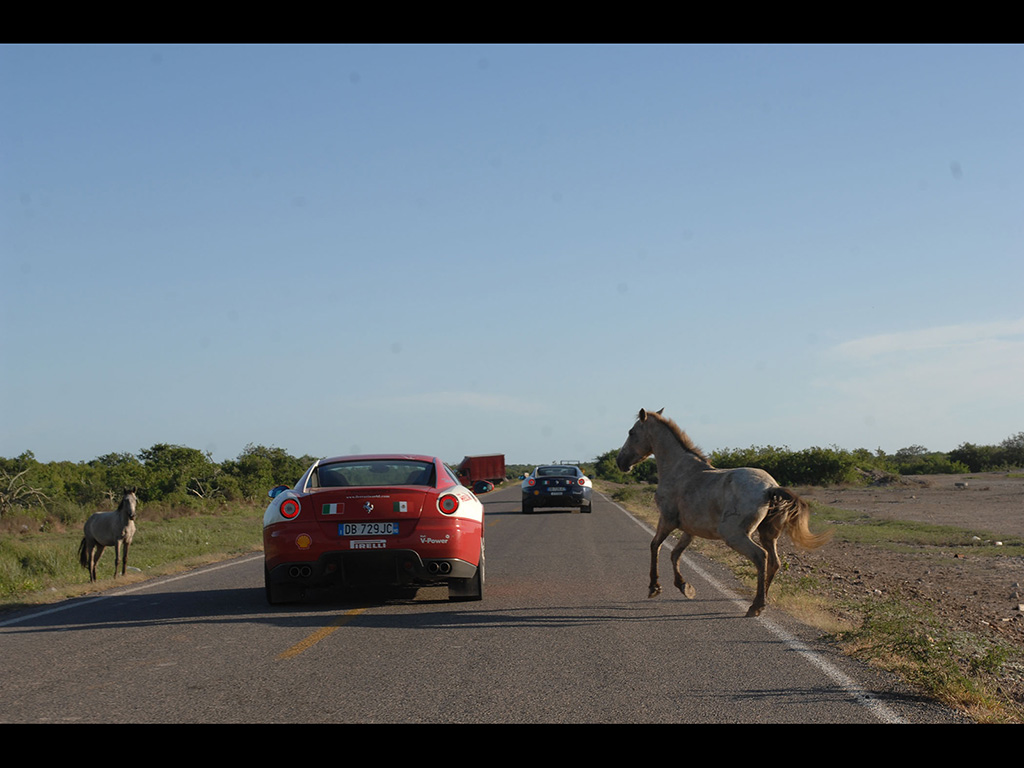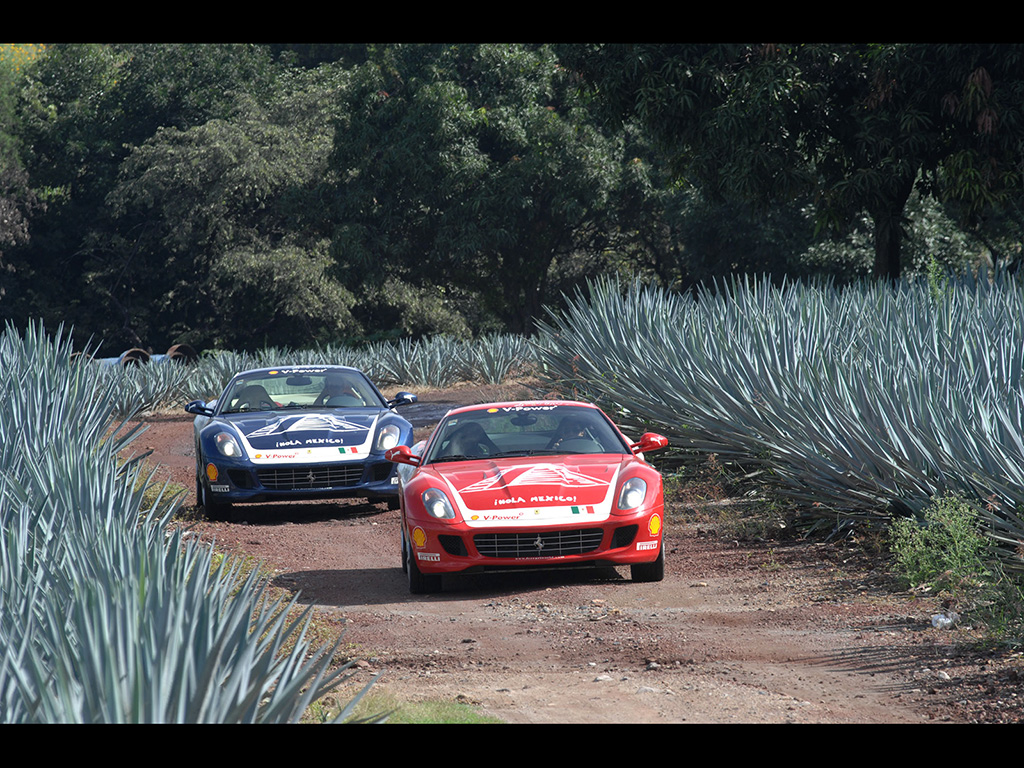2006 Ferrari 599 Panamerican 20,000 - 5
|
Price |
-- |
Production |
-- | ||
|
Engine |
6 liter V12 |
Weight |
3482 lbs | ||
|
Aspiration |
natural |
Torque |
448 lb-ft @ 5600 rpm | ||
|
HP |
620 hp @ 7600 rpm |
HP/Weight |
5.6 lbs per hp | ||
|
HP/Liter |
103.3 hp per liter |
1/4 mile |
-- | ||
|
0-62 mph |
3.7 seconds |
Top Speed |
over 205 mph |
(from Ferrari Press
Release) San Cristobal de las Casas, 11th October 2006
- Today the two 599 GTB Fiorano - already on the road for more than
six weeks along the most impressive roads through Southern and
Central America - reached the border to Mexico, leaving Guatemala
after passing through it for three days. The city is famous for its
vast and marvellous lake, surrounded by three volcanoes and lots of
little villages, which mirror themselves in the water of the lake.
The tour left Atitlan in the early morning but the members of the
team reached the Mexican border only in the late afternoon. They had
to be very patient before they could finally pass the border and
continue with their journey. The Panamerican 20,000 will continue
tomorrow with the section from San Cristobal de las Casas to
Palenque, concluding the eighth stage of the tour.
Palenque, 12th October 2006 - The team stopped for a short
visit of the city of San Cristobal de las Casas, with its unique
urban structure, low houses with only one floor, buildings and
churches. Finally the tour leaves in the direction of the
archaeological site of Palenque. The landscape is hilly and the two
599 GTB Fiorano come all the way down from the 2.000 metres in
altitude in San Cristóbal to 200 metres in Palenque. Along the road
pine trees and firs accompany the cars. The vegetation here looks
just like that of Southern Europe. The street narrows and the ups
and downs continue with lots of turns and without break.
There are many speed bumps along the road, called "tope" in the
local language. According to the local people this is the road with
the most speed bumps in Mexico. The tour arrives in Palenque just in
time to visit its archaeological site and the two Ferraris arrive at
the ancient Maya pyramids.
Veracruz, 13th October 2006 - The two 599 GTB Fiorano leave
Palenque with its humid and slightly unpleasant climate. You can
tell that this is the season with heavy rains because of the fields
often under water along the road. In this region mainly animal farms
can be seen while there are hardly any cultivated fields. For the
next 150 kilometres, until the city of Villahermosa, the street is
very narrow but flat.
Along the road, the dense vegetation sits up close to the tarmac.
The Berlinettas from Maranello can ride with a good average speed.
In Villahermosa the tour takes the highway in the direction of
Veracruz. Riding along this road the landscape is not particularly
interesting. At Cosamaloapan, around 130 kilometres from Veracruz,
the cars leave the highway to ride along the coastal road that leads
to Veracruz.
The members of the tour can admire another jewel: the village of
Tlacotalpan on the shores of the Rio Santo Domingo, featuring its
typical colonial style houses and fishermen shacks along the shore.
A short stop to take some photos and then the two 599 GTB Fiorano
proceed along the shores of the Mexican Gulf in the direction of
Veracruz accompanied by a wonderful view of the setting sun.
Ciudad de Mexico, 14th October 2006 - The two 599 GTB Fiorano
ride along the sandy coastline of Veracruz to reach the highway in
the direction of Puebla. At first, the road is flat and there are
plantations of sugar canes, bananas and pineapples. Soon, the cars
arrive at a road leading up through forests of pine and fir
resembling European flora. In Xalapa, at an altitude of 2,000 metres,
the tour reaches a plateau where several volcano craters surround
the fields. The cars stop by the side of a splendid lake bordering a
former volcano.
Proceeding, the cars drive over highways and normal roads. After
having crossed the industrial periphery of Puebla the tour arrives
at the archaeological site of Cholula, famous for the biggest
pyramid built by the Maya, where the Spaniards built the Santuario
de los Remedios church.
After shooting enough photos the tour proceeds in the direction of
Ciudad de Mexico and already 32 kilometres before the actual city
begins the first dwellings of this enormous Mexican metropolis
emerge.
Mexico City, 15th October 2006 - Today the two 599 GTB
Fiorano stopped in Mexico City, where the team members had the
possibility to visit the city. The night of the 14th October they
participated at a marvellous event and press conference organized by
the Mexican Ferrari importer, Ricardo Vega. During the day the team
visited Mexico City and organized a photo shoot using the city's
buildings as a backdrop, while some other staff members visited the
Sanctuary of the Madonna of Guadalupe.
The cars from Fiat who have accompanied the tour from the start have
now been changed to Alfa Romeo.
Tomorrow the troop
starts in the direction of Guadalajara, where the eighth section of
the Panamerican 20,000 will end.
Guadalajara, 16th October 2006 - The two 599 GTB Fiorano left
the metropolis Mexico City, after the members of the team had spent
two interesting days in this urban space with the Mexican
hospitality. After a testing exit from the city through the morning
rush hour, the team took the highway in the direction of
Guadalajara. The road with its long slopes was straddled by forests
and fields. One could still see by the side of the road that earlier
the heavy rains had flooded fields and street under.
The team decided to take a different road so the members could pass
the colonial cities Morelia und Patzcuaro. Later the cars went back
on the highway that ran along the ground, which originally was a
volcano: fertile land with many fields where the landscape is flat.
Around it all lay thick forests, while the highway was easy to use
because it was almost without any traffic.
Thanks to the better performance of the Alfa Romeo 159 - compared to
the former vehicles - the two Ferrari were able to use the
performance of their V12 engines the Berlinettas call their own. So
the journalists behind the wheels were more than pleased. The sunset
in "Rosso Ferrari" followed the cars to Guadalajara, where the ninth
section of the Panamerican 20,000 ended in the evening.
Mazatlan, 17th October 2006 - A second section on the way to
Baja California and the United States. The cars leave Guadalajara
riding along the highway along agaves and mescal cactuses in the
direction of Tequila, the city after which the famous Mexican spirit
is named.
The two 599 GTB Fiorano stop to visit a distillery in the historical
centre, before they take up their journey on the highway in northern
direction. The road is twisty and the team members can spot green
forests, agaves and tobacco farms amongst the volcanoes. But those
volcanoes have been inactive for a long time and only the central
parts, the so called "organ pipes", can still be seen.
Finally the first orchards can be spotted. Because the highway ends
here the cars have to use a normal road where they nevertheless can
ride with a good average speed.
The tour arrives in Mazatlan to watch the sundown over the Pacific
Ocean, a wonderful experience.
Topolobampo, 18th October 2006 - The Panamerican 20,000 has
left Mazatlan, with its throng of hotels dominating the beach on the
Pacific coast. Once on the motorway to Topolobambo, the 599 GTB
Fioranos traverse an area of cultivated land and the occasional
poultry farm. The scenery around here is somewhat desolate and free
of urban conglomerations.
However, the team recognises the gradual westernisation as the road
heads north. The motorways are controlled by electronic barriers and
private jets soar over the extensive fazenda lands. The journey
proceeds without fuss courtesy of the extraordinary handling of the
Maranello 12 cylinders. This evening we board for La Paz, a night
long trip before the Mexican metropolis is reached.
La Paz, 19th October 2006 - After a night spent in Italy,
given that the ship is Italian and, thus, Italian territory, we
docked again in Mexico. Once the numerous drug enforcement checks
were over, the crew headed towards La Paz. The city is situated on
the Baja California, the 1,300 kilometre long Mexican peninsular.
The zone emerged from the sea two million years ago and is now
famous for its infinite beaches.
The region is well known for its cave paintings and the churches
built by Catholic missionaries in the 1650s. Hotels, ports,
restaurants, shops and boats are everywhere. The climate is
different as one nears the desert, vegetation is sparser and the
first cacti are spotted. The 599 GTB Fioranos pay a visit to Dos
Santos to see the small Hotel California made famous by the Eagles
hit song.



